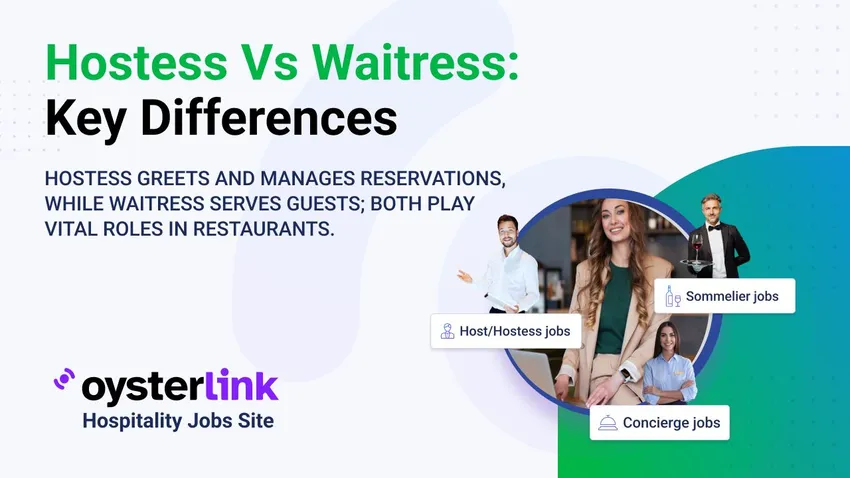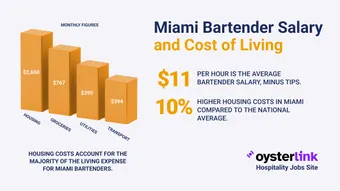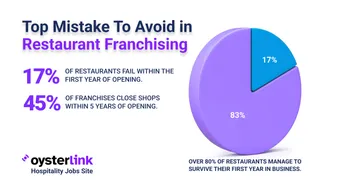Hostess vs Waitress: Key Findings
- Hostesses focus on first impressions, handling reservations, seating, and guest flow, while Waitresses manage orders, service and payments.
- Waitresses typically earn more than Hostesses due to tipping, but both roles can benefit from tip-sharing systems in certain restaurants.
- Each role offers on-the-job training and clear career growth opportunities, making them strong entry points into the hospitality industry.
To help you make the Hostess vs. Waitress distinction, we'll define both roles and explain the key differences between them in this article. For simplicity, we'll be using the terms "Hostess" and "Waitress", but note that the text applies to both male and female workers.
Difference Between Hostess vs Waitress Roles
Both Hostesses and Waitresses ensure guest satisfaction, but their duties differ. The Hostess manages reservations and seating, while the Waitress takes orders and serves food.
Additionally, there are different types of Waitresses, and they work in any establishment that serves food and drinks. Hostesses, on the other hand, are mostly employed in fine dining establishments that accommodate wealthier patrons.
Both roles require strong communication and customer service skills, with the shared goal of ensuring guests have a quality dining experience.
Hostess vs. Waitress: Definitions
To clearly understand what separates Hostesses from Waitresses, let's define both roles and look at the key skills associated with each of them.
What is a Hostess?

The Hostess is the first staff member guests meet, greeting and escorting them to their tables. They manage seating space, handle reservations, and keep guests engaged while they wait.
Most often in fine dining, the Hostess sets the first impression at the restaurant entrance. Strong communication, multitasking, and organizational skills are essential for the role.
What is a Waitress?

The Waitress takes over once guests are seated, presenting menus, taking orders and serving food and drinks. They also handle questions, special requests and payments.
Throughout the meal, the Waitress ensures service runs smoothly and guests enjoy a quality dining experience.
To do this effectively, they need a positive attitude and strong customer service skills. As they manage multiple tables, a good Waitress should also be good at multitasking and adaptability.
Advantages and Disadvantages of Being a Hostess
If you're thinking about applying for a Hostess job, it's worth to take into consideration the advantages and challenges that come with the role.
This role may suit you if you enjoy interacting with people and have strong organizational skills.

While the job isn’t physically demanding, peak hours can mean long wait times and challenging reservation management.
The table below outlines the key pros and cons of being a Hostess.
Advantages and Disadvantages of Being a Waitress
If you want to apply for a Waitress job, you may want to think about the positive and negative aspects associated with the role.
The tipping culture in the U.S. allows Waitresses to make good money, and interacting with customers can be fun. However, the role is also physically demanding and involves spending long hours on your feet.
Below, we listed all the key advantages and disadvantages of being a Waitress, but if you want to learn more about them, you can check out our pros and cons of being a Waitress article.
Here's a video that offers real insights from those with experience:
Hostess vs Waitress Earnings Compared
In case your journey in the hospitality industry is just starting and you're considering both roles, you may also want to take into account how much they earn on average.
- Hostesses receive an average hourly wage of $14.78 base plus tips. This translates to $30,750 plus tips per year.
- The average salary for a Waitress is $17.56 base plus tips per hour. This translates to $36,530 plus tips per year.
Compensation for Hostesses and Waitresses varies by venue and location. Upscale restaurants pay more, with higher tips tied to menu prices.
Some use tip-sharing systems for Hostesses, while Waitresses usually receive tips directly. In certain cases, guests may also tip Hostesses for handling reservations well.
Ultimately, both roles are considered entry-level and are a great way to enter the hospitality industry. You can become a Hostess or Waitress with no experience and develop skills such as customer service, multitasking and time management, all of which are highly valued for most roles in the field.
They also provide exposure to different aspects of restaurant operations, which can be helpful for your future career growth.
Training and Advancement Opportunities in Hostess vs Waitress Roles
Understanding the training requirements and potential career advancement for both Hostesses and Waitresses can provide valuable insights for individuals considering these roles.
Training:
- Hostess: Typically, Hostesses receive on-the-job training focusing on reservation systems, seating plans and customer service protocols. Emphasis is placed on communication skills and managing guest interactions efficiently.
- Waitress: Waitresses often undergo more extensive training, which includes learning the menu in detail, understanding food safety regulations, mastering point-of-sale (POS) systems and developing upselling techniques to enhance the dining experience.
Advancement opportunities:
- Hostess: With experience, a Hostess can advance to roles such as head hostess or shift supervisor. Demonstrating strong organizational and leadership skills may also open opportunities in restaurant management or event coordination.
- Waitress: Experienced Waitresses may progress to positions like head server, trainer, or floor manager. Exemplary performance and a deep understanding of restaurant operations can lead to roles such as Assistant Manager, Restaurant Manager, or even Sommelier, depending on the establishment.
By highlighting the training and advancement pathways, individuals can make informed decisions about pursuing a career as a Hostess or Waitress, aligning their goals with the opportunities each role presents.
Hostess vs Waitress: Conclusion
In the fast-paced world of hospitality, every role matters - and whether you're drawn to the welcoming smile of a Hostess or the dynamic hustle of a Waitress, understanding the differences is key to carving your own success story.
Both paths offer unique challenges and rewards, but at their core, they share one goal: creating an unforgettable dining experience. By mastering the skills and insights outlined above, you’re not just preparing for a job; you're setting the stage for a vibrant career in an industry that thrives on passion, efficiency and impeccable service.










Loading comments...